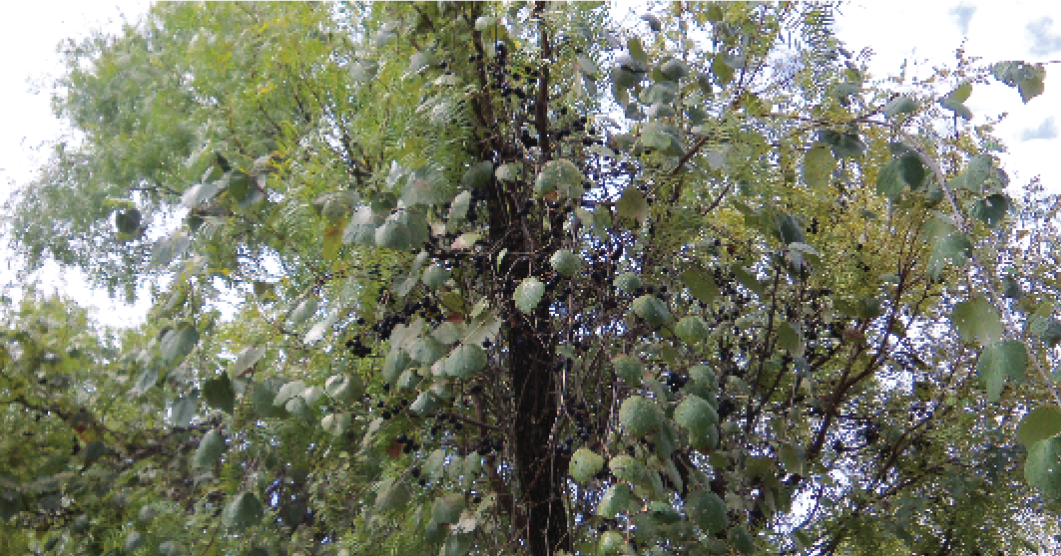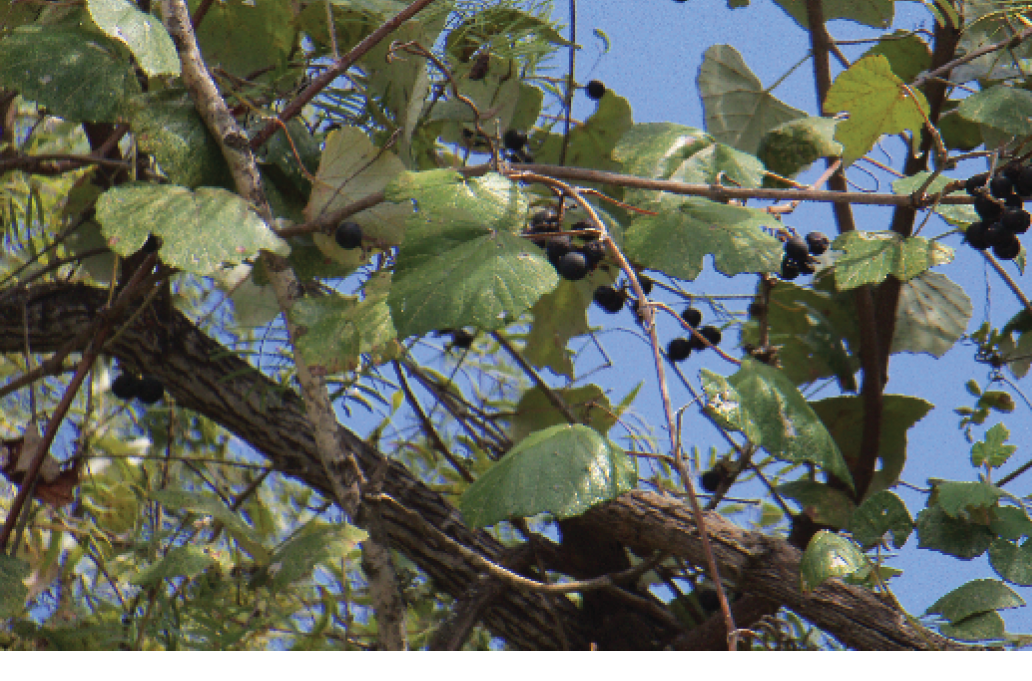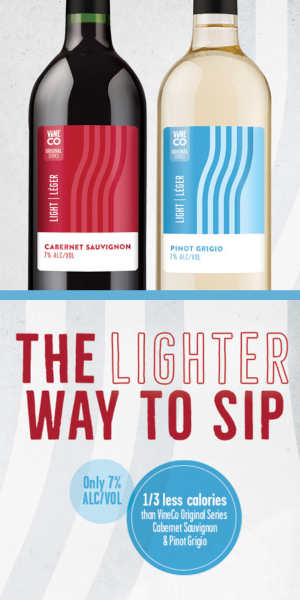
By far, the most prolific wild grape in Texas is the widely distributed Vitis mustangensis, or Mustang grape. It was historically the major wine grape of early settlers and remains a dominant choice for home winemakers in its distribution area. As popular as the wine is, there is also a great popularity in Port-style Mustang wines.
Ranging from Mexico through Texas to Oklahoma, Arkansas, Louisiana, and Alabama, the grape vine is easily recognizable from great distances by its dark green upper surface and almost white undersurface. Its tolerance of alkaline soils and deep root structure allows it to naturally thrive where other grapes will not and tolerate surface droughts for indeterminate periods. But it tolerates acidic soils as well, allowing it to grow among the pine and hardwood forests.
The name “Mustang” is sometimes confused with the similar sounding Muscadine grape. Although they are both thick-skinned and overlap geographically, Muscadines (Vitis rotundifolia) are a separate species and have different organoleptic properties. Likewise, the wines they produce are very different.
The Mustang Grape
Mustang grapes grow in clusters rather than bunches. Typical berries are 5⁄8 to 7⁄8 inch (14–22 mm) in diameter, spherical, with 4–9 grapes to the typical cluster. Grape diameters of 1 1⁄4 inch (3.2 cm) and clusters of 19–21 grapes are not unheard of, but more than 7⁄8 inch (2.2 cm) and clusters containing more than 11 grapes are both uncommon.
Most Mustangs ripen to a purple-black to nearly pure black skin, but bluish-purple, reddish-purple, reddish-pink and bronze (the so-called white Mustang) are within the normal characteristics of the grape.
The vines are identical botanically regardless of the color of the grapes. The rarest of the colors is the bronze, which can reliably be propagated only from cuttings or layering, the seeds being untrue to berry color.
The vines can grow to great size, both in girth and cane length. They will climb to the top of any tree they can scale, completely cover smaller trees and bushes, form a dense groundcover where no tall growth is present, and form a dense, linear fence-covering.
Dense growth is a sign of an underground aquifer or stratified water table. The deepest excavated root structure reached down to 65 feet and deeper structures seem entirely plausible.
Their leaves vary from heavily-lobed as juveniles to a lobeless heart or shield shape at maturity. A characteristic of the mature leaf is an umbrella-like curvature with drooping edges which resists standing water and, when thickly layered, protects the clusters fairly effectively from sun and rain. They are a mid- to dark-green on the adaxial side (the side facing the stem, i.e. the upper side) to a dusty- to silvery-white on the abaxial (under) side. The adaxial is shiny, the abaxial is characteristically wooly.
Moving from the southern edge of its range to the north, ripeness begins in June through August, usually lasts about 4–6 weeks, but late hanging clusters are known but not usual. Where found, the late hanging clusters make the best wine.
Wine color is normally a light claret to deep garnet, but rosés, blushes and even true whites can be made.
Mustang Grape Wine
To make Mustang grape Port, one should understand the basics of making Mustang grape wine. Since Port is essentially a high alcohol wine, it is important to understand making the wine before progressing to the Port. We crawl before we walk. (See the recipe below.)
The grape is highly-flavored, high in acid, rich in tannins and low in sugar. This combination presents challenges to the winemaker. The natural flavor of the grape, except the bronze, is usually unpleasant to most people but with help is fortunately altered by fermentation. Coping with the flavor requires adjustment of the quantity of grapes per gallon. Coping with the acidity requires amelioration. Coping with the tannins requires careful judgment on how long to macerate on the skins, a decision that will also affect color. Coping with the low sugar necessitates chaptalization. Juggling these can rise to an art form.
The amount of grape by weight in each gallon of must determines the wine’s flavor, body, acidity and tannic qualities. The minimum amount used in Port should not be less than 8 pounds per gallon (0.95 kg/L) but 12 pounds per gallon (1.4 kg/L) is best. Because Mustang grapes have a thicker and heavier skin than V. vinifera, Mustang grapes produce about half the volume of juice per pound than do vinifera. The figures in Table 1 (below) should apply, but are not chiseled in stone.
Fully-ripe Mustang grapes contain a small amount of free-run juice trapped between the skin and the pulp. This juice is richly colored and highly acidic, but the acid declines as the grape passes optimum ripeness. It is low in sugar, with a sugar content between 6–10 °Brix, but strongly flavored. Juice trapped in the pulp is also acidic but sweeter and less flavorful than the free-run but essential for making wine or Port. Its release is aided by a 3–5-day carbonic maceration or a generous dose of pectic enzyme at least 12 hours prior to pitching an activated (rehydrated) yeast culture.
Table 1: Mustang Grape Juice Yields

Chaptalization requirements are fairly straightforward, but cannot be calculated until after amelioration (with water). Table 2 (below) assumes the yields described in Table 1 (in pints), amelioration to 1.0 gallon (3.8 L), and a generous sugar content of 8 °Brix before amelioration. There is little natural sugar in the diluted must, but the actual amount should be verified with a hydrometer or refractometer. The potential alcohol (16%) in Table 2 is used with the intent of arresting fermentation at 12% alcohol by volume (ABV) with the addition of brandy sufficient to raise the ABV to 18–22%, according to your taste.
Table 2: Chaptalization Requirements for Mustang Musts
The Mustang’s high acidity is easily reduced by ameliorating with water. Acidity as high as 14 grams per liter (14 ppt, or 1.4%) is not uncommon in Mustang juice. It should be reduced to around 7.5 grams per liter (7.5 ppt, or 0.75%). Indeed, in Table 3, acid actually needs to be added to most formulations to achieve this high value. However, if you are happy with the values after amelioration, do not add any acid blend.
Table 3: Acid Corrections for Mustang Musts to 0.75%
The starting specific gravity of 1.118 can cause problems for some yeasts; they simply will not start in a density this high. For that reason, the Port winemaker should select one of the following yeasts, which will both start at this density and ferment to 16% ABV or higher if allowed.
These yeasts should be hydrated in a starter solution and husbanded for 12–16 hours to produce a high yeast population prior to introduction to the must.
Red Star Pasteur Red — Temperature range is 64–86 °F (18–30 °C), but should be kept under 75 °F (24 °C) for best results; alcohol to 16% ABV.
Lalvin BDX — Temperature range is 64-86 °F (18–30 °C) but should be kept under 75 °F (24 °C) for best results; alcohol to 16% ABV; requires high levels of nitrogen nutrients.
Lalvin ICV-D21 — Temperature range is 64–96 °F (18–36 °C) but should be kept under 80 °F (27 °C) for best results; fast fermenter; alcohol to 16% ABV.
Lalvin K1-V1116 — Temperature range is 50–107 °F (10–42 °C) but should be kept under 80 °F (27 °C) for best results; fast fermenter; alcohol to 20% ABV; requires high levels of nitrogen nutrients.
Lalvin RC 212 — Temperature range is 68–86 °F (18–30 °C) but should be kept under 75 °F (24 °C) for best results; alcohol to 16% ABV.
Building Body in Mustang Grape Port-Style Wines
One expects Port wines to possess higher alcohol, fuller body and a balancing sweetness. There are two fairly easy ways to increase the body in Mustang grape Port-style wines. One is to add light dried malt extract or extra light dried malt extract to the must and the other is to add banana to the must. Malt extract is a product used extensively in the homebrewing world. It usually is made from malted barley but can also be made from malted wheat. It is a powder, easily measured, with a longer shelf life than liquid malt extract and is considerably less messy to work with. While barley can be used directly in winemaking as a body builder, the dried extract is so easy to use that barley grain is not frequently used.
Bananas have long been known as a body builder. Fresh bananas can be chopped and added directly to the must or boiled, skimmed, strained, and the water incorporated into the must. It is considerably easier to use dried banana flakes or slices added directly to the fermenting must. Between the two, the flakes seem more efficient. Both body builders are used separately in the recipes found below.
Fortifying Mustang Wine to Make a Port-Style Wine
Yeast in a fermentable environment will not stop fermenting and expire simply because we wish it. Because we are using a yeast that will ferment the must to dryness, we must intervene aggressively to arrest fermentation and kill off the yeast. We do that by adding sufficient brandy or other spirit to exceed the toxicity threshold of yeast and cause their death.
How much spirit to add depends on what proof you are adding to achieve your targeted alcohol by volume. This must be calculated, but thankfully one doesn’t need to know algebra to do it. A simple tool for calculating this, used for ages, is the Pearson Square.
Pearson Square
To use the Pearson Square, you need to know three things to solve for the other two. If you know the alcohol content (ABV) of the fortifier (A), the alcohol content (ABV) of the wine to be fortified (B) and the desired alcohol content (ABV) of the Port you are making (C), you can calculate the ratio of the wine (D) to fortifier (E).
For example, if the fortifier is 80-proof (40% ABV) brandy, the wine is 14% ABV Mustang wine and you want a 20% ABV Port, subtract B (14) from C (20) to solve D (6 parts of brandy) and subtract C (20) from A (40) to solve E (20 parts of wine), or 3 parts brandy to 10 parts wine. If you have 1.0 gallon (3.8 L) of Mustang wine, you need to add 3⁄10 of that amount (38 fluid ounces or 1.1 L) of brandy, or roughly 4 cups and 6 1⁄3 ounces. The result will be 4.9 L of Port, or six 750 mL bottles, one 375 mL split and a shot for your efforts.
When to Stop Fermentation
The objective is to stop the fermentation at 12% by adding more alcohol than the yeast can tolerate. This should occur when the wine reaches a specific gravity of 1.028. This endpoint specific gravity is calculated as 118 (the starting gravity for a wine of 16% ABV) minus 90 (the starting gravity for a wine of 12% ABV). In this equation, “gravity” is specific gravity with the “1” and the decimal point removed. To convert gravity to specific gravity you put the “1” in front of the gravity number, which should be expressed as three digits. If the gravity number is less than 100 — in other words, expressed with two digits — add a leading zero. (For example, 90 would be equivalent to a specific gravity of 1.090.)
To hit that magic number requires close observation and frequent measurement, meaning you will have to remove that airlock more than you might like. Don’t be too concerned. The wine was sulfited before fermentation. And if you decide to add the brandy at 1.035 instead of 1.028, just recalculate your ABV based on a fermented specific gravity of 1.083 (starting gravity of 118 minus ending gravity of 035 equals a fermented gravity of 083 or SG 1.083 — about 11.2% ABV). If you don’t catch it until 1.020, use your hydrometer table to calculate a finished ABV of 13.3%. Try to hit 1.028, but work with what you have.
The recipes below will guide you towards making your own Port-style wine from Texas’ native grape.

Mustang Wine Recipes
Mustang Grape Wine
(1 gallon/3.8 L)
The must will be made to reach a potential alcohol level of 16% ABV, but a yeast strain with an alcohol tolerance of 14% ABV will be used to allow residual sugar and produce a semi-sweet wine.
Ingredients
8 lbs. (3.6 kg) black Mustang grapes
3 lb. 1⁄2 oz. (1.4 kg) granulated sugar
½ tsp. acid blend
¾ tsp. pectic enzyme
5 pints (2.4 L) water
1 crushed Campden tablet
1¼ tsp. yeast nutrient
Lalvin 71B-1122 wine yeast
Step by Step
Remove the stems and wash the grapes. While wearing rubber gloves, crush the grapes in a crock or plastic primary. Add all ingredients except pectic enzyme and yeast. Stir well and cover for 12 hours, then add pectic enzyme. Wait another 12 hours and add activated yeast in an established starter solution. Push down the cap and stir twice daily for 5 to 7 days. Strain and press pulp well to extract liquid. Pour into secondary fermentation vessel, fit airlock, and let stand three weeks. Rack and top up, then rack again in three months, stabilize (crushed Campden tablet and 1⁄2 teaspoon potassium sorbate) and fining agent if desired, or set aside another month. Rack off of finings ten days later, set aside another month and bottle.
You may taste the wine immediately, but it improves remarkably out to about 4 years.
Mustang Grape Port (1)
(1 gallon/3.8 L)
This recipe uses heat to extract color, tannins and juice from the grapes. One can eliminate the heating and simply crush the grapes cold and ferment as usual. The heat produces a deeper colored and more tannic Port-styled wine, capable of aging for many, many years.
Ingredients
10 lbs. (4.5 kg) ripe Mustang grapes
2 lb. 15.2 oz. (1.3 kg) granulated sugar
1⁄2 cup dried malt extract
4 pts. 6 oz. (2.1 L) water
1 crushed Campden tablet
¼ tsp. acid blend
1 tsp. pectic enzyme
1 tsp. yeast nutrient
recommended wine yeast
fortifying spirit
Step by Step
Wash and destem the grapes. Place in large stainless steel pot with one cup of water and set over low to medium heat, covered, but do not allow to boil. Stir with wooden paddle every few minutes until grapes break apart and juice oozes out. Allow to cool in the pot. Meanwhile, boil remaining water and pour over sugar in crock or plastic primary, stirring to dissolve. When water has cooled, stir in dried malt extract. When grapes are tepid, pour grape juice and pulp into primary with juice. Add water mixture, acid blend, yeast nutrient and pectic enzyme. Cover and set aside 10–12 hours. Add finely crushed Campden tablet, stir, cover, and set aside for another 10–12 hours. Add yeast in a starter solution and re-cover primary.
Use wooden paddle to push down cap twice daily for 5 days. Strain pulp into nylon straining bag and press pulp well to extract residual juice. Add pressed juice to primary and measure specific gravity. Retain in primary until target SG (1.028) is reached. Add the required (calculated) amount of spirit into a sanitized jug or carboy and transfer wine into that vessel to make the Port blend.
Rack the Port after 30 days and again 30 days after that. If you later decide it needs another racking, you can postpone that until bottling.
If you wish to add oak or mesquite, do so after second racking. Taste periodically to decide when to remove wood. When the Port is approximately 6 months old from fortifying date, taste and decide if it needs additional sweetening to achieve balance. Bulk age until next Mustang harvest and then bottle. It improves remarkably with age.
Mustang Grape Port (2)
(1 gallon/3.8 L)
Ingredients
10 lbs. (4.5 kg) ripe Mustang grapes
2 lb. 15.2 oz. (1.3 kg) granulated sugar
3.25 oz. (92 g) dried banana flakes (or 8 oz./230 g dried banana chips)
4 pts. 6 oz. (2.1 L) water
1 crushed Campden tablet
¼ tsp acid blend
1 tsp pectic enzyme
1 tsp yeast nutrient
recommended wine yeast
fortifying spirit
Step by Step
Follow the same procedures as in the first recipe, except wait until you add the activated yeast in a starter solution to stir in the banana flakes.
The remaining instructions from fermentation on are the same.







